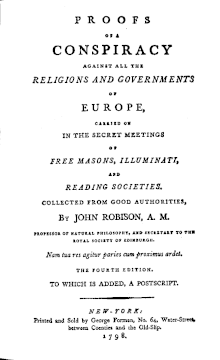John Robison (physicist)
John Robison (born February 4, 1739 in Boghall, Baldernock , Stirlingshire , † January 30, 1805 ) was a Scottish mathematician, chemist and physicist. He was Professor of Natural Philosophy (Physics) at the University of Edinburgh . From 1783 to 1798 he was the first general secretary of the Royal Society of Edinburgh .

Life
Robison was the son of a businessman from Glasgow and studied at the University of Glasgow with a master's degree in 1756. After a short stay in London, he went as a midshipman to the Royal Navy and was involved in the expeditions to Québec and Portugal . He particularly excelled there in navigation. On his return he worked for the Board of Longitude , which tested John Harrison's watch on a sea voyage to Jamaica in 1760/61 . Back in Glasgow, he dealt with chemistry and in 1766 succeeded Joseph Black as Professor of Chemistry at the University of Glasgow. From 1770 to 1773 he accompanied Admiral Charles Knowles as his private secretary to Saint Petersburg , where Knowles was supposed to reform the Russian Navy and Robison taught mathematics to the cadets at the Naval Academy in Kronstadt from 1772 as a professor . On his return in 1773 he became a professor of natural philosophy at the University of Edinburgh and gave lectures on various branches of physics, which were also published as books. His approach to the natural sciences was very practice-oriented. He also advised government agencies and industry during his tenure as a professor in Edinburgh.
In 1769 he recognized before Coulomb that electrical charges of the same type repel each other according to Coulomb's law (as did Henry Cavendish ). He worked with James Watt , including on a steam-powered car project, and testified in favor of Watt as the inventor when he ran into financial difficulties. He is also considered to be the inventor of the siren , which he used for organs at the end of the 18th century, even before the French Charles Cagniard de la Tour (1819).
Robison was part of the Scottish Enlightenment Movement . He wrote over forty articles for the Encyclopedia Britannica (3rd edition 1797) popularizing the natural sciences and dealing with hydraulic engineering and maritime topics.
In 1797 he published the book that would make him famous: Proofs of a Conspiracy against all the Religions and Governments of Europe, carried on in the Secret Meetings of Free-Masons, Illuminati and Reading Societies (“Proofs of a Conspiracy Against All Religions and Governments of Europe, carried out in the secret gatherings of Freemasons, Illuminati and reading societies ”). In it, Robison put forward the conspiracy theory that the Illuminati , a radical Enlightenment secret society dissolved in 1785, infiltrated the European Freemasons and thereby triggered the French Revolution . These theses were widespread and intensively discussed in the heated climate of the 1790s. In New England they triggered a downright Illuminati panic.
In 1803 he edited Black's Lectures on Chemistry. In 1804 he published the first volume of his Elements of mechanical philosophy , the only one of the volumes that appeared (on dynamics and astronomy).
In 1783 he was elected a member of the Royal Society of Edinburgh . In 1798 he was awarded an honorary doctorate from what would later become Princeton University and in 1800 an honorary member of the Russian Academy of Sciences in Saint Petersburg .
His son John Robison (1778-1843) made it as a military advisor in India to prosperity and was an inventor.
Individual evidence
- ↑ Peter Knight and Jeffrey L. Pasley: Robison, John . In: Peter Knight (Ed.): Conspiracy Theories in American History. To Encyclopedia . ABC Clio, Santa Barbara, Denver and London 2003, Vol. 2, p. 622.
- ^ Fellows Directory. Biographical Index: Former RSE Fellows 1783–2002. (PDF file) Royal Society of Edinburgh, accessed April 3, 2020 .
- ^ Foreign members of the Russian Academy of Sciences since 1724. John Robison. Russian Academy of Sciences, accessed October 20, 2015 .
literature
- Peter Knight and Jeffrey L. Pasley: Robison, John . In: Peter Knight (Ed.): Conspiracy Theories in American History. To Encyclopedia . ABC Clio, Santa Barbara, Denver and London 2003, Vol. 2, pp. 621 f.
- Claus Oberhauser: The conspiracy-theoretical triad: Barruel-Robison-Starck . Studienverlag, Innsbruck-Vienna-Bozen 2013 ISBN 978-3-7065-5307-0 .
Web links
- Papers of John Robison, NAHSTE ( October 12, 2013 memento in the Internet Archive )
- Biographical Memoires of Dr. Robison, Philosophical Magazine, 1802, Archives
| personal data | |
|---|---|
| SURNAME | Robison, John |
| BRIEF DESCRIPTION | Scottish mathematician and physicist |
| DATE OF BIRTH | February 4, 1739 |
| PLACE OF BIRTH | Boghall, Baldernock, Stirlingshire |
| DATE OF DEATH | January 30, 1805 |
